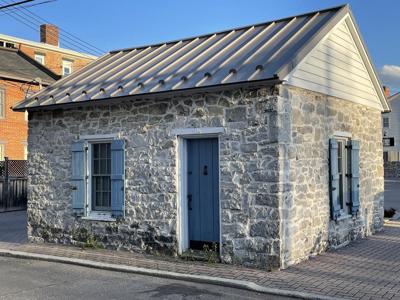When the Scribbler was a senior at Dickinson College in the mid-1960s, he knew a 68-year-old man named Whitney Wells. Wells was a former Harvard University instructor who enjoyed drinking 8-ounce glasses of beer and shots of whiskey for hours in a tavern in downtown Carlisle, where the Scribbler also spent too much time.
Wells wrote for the Carlisle Sentinel. He typically completed his shift at the newspaper in the late afternoon, walked several blocks to the bar and spent the rest of the night there.
Then he shuffled home to a small gray limestone house he rented at 116 Dickinson Ave, just over a block away.
Wells’ dwelling place is known as the “Butler Gun Shop.’’ It was built as early as 1761 by Thomas Butler, a well-known gun repairman who had moved to Carlisle from Lancaster.
Born in Ireland in 1720, Butler emigrated to Lancaster in 1748. He was associated with Joshua Baker Sr., a noted local gun barrel maker.
Butler and his wife had 12 children, five of whom, all high-ranking officers, fought in the Revolution. They are known as “the fighting Butlers,’’ thanks to a remark George Washington made at the end of the war.
In 1760, Thomas Butler moved his growing family from Lancaster to Carlisle. His lot was large, extending from West High Street (Route 11) back to the alley called Dickinson Avenue. He probably lived in a house located at 117-119 W. High St. while repairing weapons in the nearby gun shop.
Butler supplied arms to the Revolutionary militia. He enslaved at least one African American named Abel, who escaped in 1763. An active member of the Church of England, Butler helped ensure that St. John’s Episcopal Church was completed on Carlisle’s square.
Butler died in 1787 on a large farm he had purchased just west of Carlisle.
The gun shop eventually was sold outside the family and used for various purposes, including as a shoe repair shop. A later owner renovated the building before Whitney Wells settled there in the 1950s.
Wells lined that little building, roughly 12 feet by 10 feet, with books. There wasn’t much else in there. The Scribbler visited the book-bedecked home one time to continue a discussion about literature and life.
A California native with bachelor’s and master’s degrees from the University of California, Wells taught at Harvard University throughout the 1920s. Then his life changed. A Carlisle Sentinel columnist observed following Wells’ death that his “fortunes had shifted as a result of a close association with John Barleycorn.’’
(John Barleycorn is a fictional and humorous personification of alcohol.)
Although he was a damaged and disengaged alcoholic by the time he reached Carlisle, Wells retained reams of literature in his head. He quoted lengthy passages from Shakespeare. He claimed to have met several famous American authors. He was a literary inspiration, as well as an engaging drinking companion.
On the early morning of April 18, 1973, the inside of the Butler Gun Shop burned. The stone walls survived. Whitney Wells did not.
The building has been restored and its surroundings have been altered. Several nearby buildings have been demolished and replaced by parking lots.
It is doubtful that many people know what or even where the Butler Gun Shop is. The state historical marker for the shop that formerly stood on High Street has disappeared.
The remains of Whitney Wells rest in a California cemetery.
Jack Brubaker, retired from LNP | LancasterOnline staff, writes “The Scribbler’’ column every Sunday. He welcomes comments and contributions at scribblerlnp@gmail.com.

